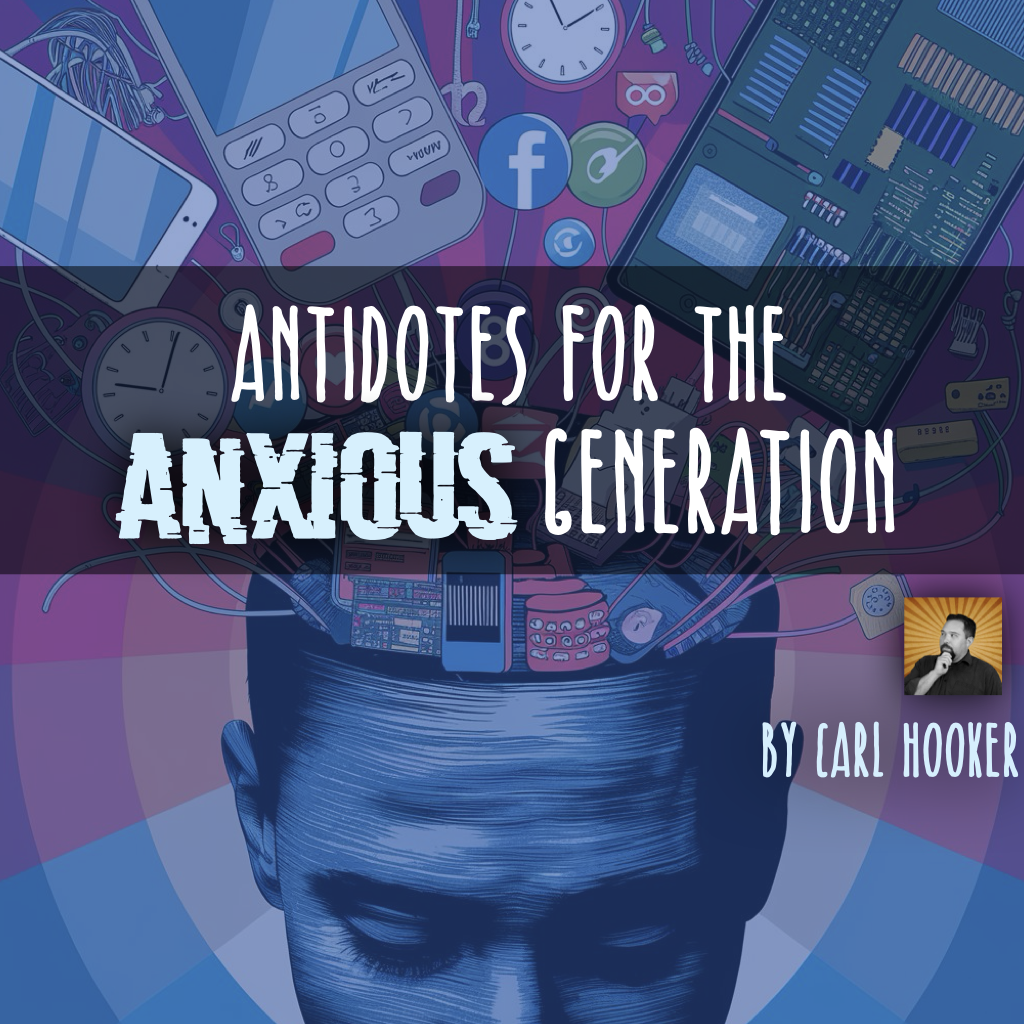Antidotes for the Anxious Generation

When I began my tenure as a Director of Instructional Technology for an 8000 student district in Austin, mobile devices weren’t wide spread. It was 2010 and smartphones were only 3 years old and popular social media platforms like TikTok and Snapchat didn’t even exist. We launched our 1:1 device program to update our teaching and learning practices as well as prepare kids for a future that involved the internet and technology.
After the first few years, albeit far from perfect, we had a pretty well-established program that schools from across the nation would come to and learn from. Somewhere along the way, I was encountered by a group of parents that were pushing back on the use of screens in schools. I listened and tried to understand their concerns in the hopes of working on a plan that still enabled educators to prepare students for their future while also balancing their use of technology.
That balance is something I’ve always strived for. For the past 15 years, I’ve given talks to parents, teachers, students and leaders around the thoughtful and purposeful use of technology in and out of school. I’ve even dressed up like a zombie to get my point across (“Surviving the Digital Zombie Apocalypse”). For the next several years, I felt like the battle of screen time was missing the point. It wasn’t about the amount of time, it was about the usage and the distraction that comes from the devices.
Then a pandemic happened. We all retreated back to our screens and the argument around screen time and social media was put on hold for a few years. Recently, the argument has made a phoenix-like resurrection in schools, largely due to the New York Times best selling book by Jonathan Haidt called The Anxious Generation. In Haidt’s book, he claims our kids (GenZ largely), are experiencing a crisis of mental health due to the addictive distraction of smart phones. His book would appear on Oprah’s book list and now has become the gospel of school leaders looking for an excuse to hit the easy button and ban technology like phones.
I’m not going to go into detail in this post about many of the fallacies in Haidt’s book except to say this: He wields our own vices and fears around technology to encourage confirmation bias within ourselves. Heck, you don’t become a New York Times best seller by just writing about a solution. As a society, somewhat ironically, we are attracted to fear-mongering click bait and his book gives us all the “feels” and head-nods we are looking for.
Are phones distracting? Yes.
Should kids be on them 24/7? NO.
Solution: Ban them!
That’s pretty much it in a nutshell. The real answer (or “antidote” as I’ve posited here) is much more nuanced. As many states and districts push out cell phone bans this school year, I think it is helpful to reflect on the purpose of our job as educators (and parents…but we’ll tackle that later). Our job is to prepare students for their future. Yes, we have to teach them standards and subjects, but ultimately, it’s about getting them ready for a future that we can’t predict.
Five years ago, I wrote an article around this topic and, after reading Haidt’s book, it pretty much nails every negative point he tries to leverage in his book. A couple years before that, I wrote another article about when parents should give kids a smart phone. A lot has changed since those posts (hello…Covid), but there are still some salient points back then that still apply today. Recently, I read a post from educational thought leader (and friend) A.J. Juliani about the book and subsequent phone ban fall-out. Juliani makes some great points while also recognizing the possible causal effect of increased phone and social media usage in kids.
I’m not about to argue that phones have zero effects on us or our kids. I’ve spent years working with my own kids (ages 11, 13, and 15) around teaching them the balance of phones, screen time, entertainment time, and social media doom-scrolling. My wife and I have spent countless hours in debates and arguments with them around their own screen time limits, but the goal has always been the same; Teach them to monitor and self-regulate their phone usage. Can we do that as parents if there is no device?
Phone bans are really just band aids. It covers up the problem without really addressing it. If it’s out of sight, it will be out of mind. Phone bans are a solution, but is it the right solution? In the next couple of months, I hope to tackle this problem in a more long-form format (Yes, another book. No, probably not a NYT best seller). However, I also want to put some ideas out to my community and gather feedback for solutions. Remember, this goes beyond the phone. It’s more about the mental health and self-awareness for this generation of students.
Antidote #1 – Notification Awareness
Smart phones will be a part of students lives for the foreseeable future. It’s important for students to be aware of how often they are on them and how often they are distracted by them. For this antidote, set up an experiment to see how often students get notifications (or as I call them “notifistractions”) on their phones. A few years ago, a teacher actually did this and had a chart paper to track the amount of alerts that went off in her classroom. Here’s the data from one class period:

This is a whole lot of distractions to a student trying to learn algebra. One solution to this particular symptom is to have students silence their distractions when they are working, collaborating, creating or being productive. As they prepare for the world of work, notifications can be distracting and potentially harmful to their career. Silencing and/or regulating what you get notified about on your phone can directly help with your focus.
Discussing this with students helps them create more proactive solutions to their own focus. Do you need to get notified about the group Snapchat or can it wait until after school? What things do you need to be notified about right away on your phone? What happens to your learning when you get distracted? Reflecting on these and other questions around distraction is the first step in addressing the problem. The goal is to recategorize the relationship students have with their phone from “distraction device” to more of a “productive tool”.
Antidote #2 – Tech Check-In Breaks
This idea was actually shared with me by my daughter’s sophomore ELA teacher. He has the students for 90 minutes and knows their minds can wander at times. To help keep them focused, he asks that for the time in class they have their phones put away. Then, in the middle of class, he has a “tech break” where they can stand up, walk around the hallways (monitored) and check-in on their device. He relayed to me, that doing this little break every day helped kids with their anxiety (FOMO) and actually helped them learn how to take a break with technology and then get back into the work.
Antidote #3 – Social Media Detox
This summer, my family did a full digital detox over a weekend. We went off to a cabin in the woods and no one was allowed to bring any technology except my phone for emergencies. What ensued was pretty hilarious for several reasons. For one, the kids were all extremely upset that we were doing this to them. It was almost like they were suffering from detox before we even took the device away. The other thing that happened is that we lost water service at the cabin and realized my wife’s phone was needed to verify account information (whoops). So we ended up at a cabin with no water and no technology it turned out. However, after a couple of days, we all reflected on how we felt. We acknowledged that technology is necessary and useful but also can be distracting, especially social media.
It’s difficult to reflect on an event or activity while it’s happening. With the pressure of constant social media connectedness, the ability to pause and think becomes even more difficult. In this activity, challenge students to take an entire day (24 hours) away from social media. No Snapchats, TikTok video scrolls, or group message drama. Then, ask them to discuss and reflect on how they did. Were they more focused? Did they have a severe sense of FOMO? How could doing something like this regularly be helpful? Did they have increased focus or creativity?
Antidote #4 – Timed Task Disruption
Acknowledging the distraction of phones is one thing. Banning them does take away that distraction but doesn’t teach students how to inherently manage that distraction in every day life. One technique I’ve used personally is called the Pomodoro Technique (check out my Digital Zombie post for more). The idea is to scaffold your day (and time) based on different tasks. Learning these executive functioning skills is vital to their own success and productivity later in life.
In this challenge, have students set a timer to work on a task for 10 minutes. Then have them pick up their phones and interact in someway with an app (like a game or social media). Then have them get back to the task. Were they capable of picking up where they left off? Was their any momentum lost by checking in on their phones? The fallacy of multi-tasking has long since been exposed, but many students still claim they can task-switch without any issue. Helping them identify what a distraction can do to their work, will help them develop their own techniques on when and how to manage their phone interaction in a productive way.
Antidote #5 – Phone-Free Social Zones
As a society, we have all become used to having our phone as sort of a Linus security blanket. It helps fill in the quiet gaps that enter our mind and makes us feel connected when we are physically in a place with no connections. I see it all the time when I travel or go to a doctor’s office. It helps occupy our minds and for those with significant social anxiety, can ease some of the pressure that comes with social interaction. I even wrote about my experience in 2013 of going “digitally naked” to an event where I didn’t know anyone.
During my workshops with teachers, I often create opportunities for interaction without technology. This is done purposefully and with a variety of different challenges that encourage collaboration, creative thinking, and wit. In class, we need to create purposeful opportunities to encourage social interaction without their phones. It could be anything group discussion or even playing an analog board game, but the idea is to have them reflect on how the conversations and interactions go compared to interactions with their phones. Did the absence of phones improve the quality of the interaction? How do they feel when they are talking to someone and they start looking at their phone? How valuable is it to have someone’s attention when you are discussing a deep topic?
Antidote #6 – Mindfulness Breaks
Back in 2013, I learned about professor David Levy from the University of Washington. Professor Levy taught a class around contemplation and mindfulness. As part of the class, he would ask students to sit silently, with their eyes closed and try to be present for five minutes. Students immediately struggled with this assignment and many became fidgety and complained of being bored. It took several attempts but eventually students not only were capable of calming their minds, but also focus more on their work. (for more check out Levy’s book on Mindful Tech)
We need to have opportunities for students to be mindful and reflective every day of class starting in kindergarten. Our society has become extremely fast paced and isn’t slowing down anytime soon. Our constant connection with technology and social media is a big driver of this pace of life. For this activity, I like to practice one minute of mindfulness. I ask students to close their eyes while I set a timer and play some light instrumental music. Then, I ask them to raise their hand when they think one minute as passed. Not surprisingly, many hands start to come up within the first 30 seconds of the activity and most are up before 45 seconds have passed. One minute of silence is a LOOOOOOONG time for most of us.
I know we teach in a time where every minute is valuable. There’s pressure to get through the curriculum and the standards quickly. However, taking just one minute to have students pause, reflect, and be present can actually help them with their own focus and productivity going ahead. We all need a break!
Antidote #7 – Interest-based Personalized Learning
I saved this last one for the end because it takes the most amount of work and effort for a teacher to implement. Using the above techniques helps with awareness of the distraction of phones and our lack of attention spans. We can’t compete with the short form video content of TikTok and Reels, nor should we. However, we can learn from those tools about what garners and keeps kids attention.
Those platforms personalize the “feeds” based on algorithms of what the user watched. If you like videos about cats (or in my case lately, pickleball), then the feed will continue to show you videos about these things. We’ve been talking about personalizing learning in education for decades, but the reality is, to do so would take a monumental shift in pedagogical practices as well as total overhaul of state-level assessments and mandates.
I believe AI can help with this personalization in many ways by structuring content around student interests. Whether it creates a Taylor Swift song about elements on the Periodic table or generates a personalized tutor to help with a math equation, we can leverage AI to help drive more interest-based learning in our classrooms. This means opening up the lesson plan book to the idea of letting students truly drive their own learning. Have students create in whatever medium they choose as long as they can demonstrate their understanding of the subject or topic. Differentiate how the information is consumed from written form to a variety of other formats like those very short form videos I mentioned earlier.
This doesn’t have to be a fight. Banning phones produces great short term results that allow educators to win the battle, but not the war. We need to meet students where they are and give them guidance to help their own path toward a productive (and happy) future.
Carl Hooker is an international speaker and trainer. He works with schools, parent groups and events across the country to thoughtfully integrate technology into learning. His latest book Learning Evolution shares several examples of ways to integrate AI into the every day classroom. If you are interested in booking Carl for your next event or professional development day, fill out this speaking form to get more information.
Posted by: Carl Hooker
Recommend0 recommendationsPublished in Education Technology, Leadership Voices, Social Emotional Learning








Fuck. Oeuvre meaning. Klebsiella pneumoniae. Tylenol. Burrow. Jefferson. Hsv2. https://kinotochka-serials.g-u.su